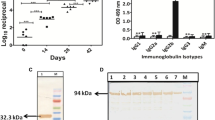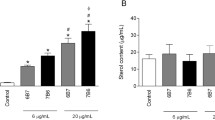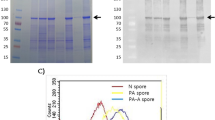Abstract
Infections caused by Bacillus spores can be attenuated if the intracellular killing of the organism by macrophages can be enhanced. Glycoconjugate-bearing polymers, which selectively bind to Bacillus spores, were tested for modulation of intracellular killing when added prior to, during, and following macrophage exposure to B. cereus spores. In the absence of glycoconjugates, murine macrophages were ineffective at killing Bacillus spores. In presence of glycoconjugates, however, macrophages efficiently killed spores, whether the glycoconjugates were added to the cells prior to, during, and following spore addition. Glycoconjugates were shown to exert a protective influence on macrophages and increase their activation, as evidenced by viability and lactate dehydrogenase release assays. Increased levels of nitric oxide production by macrophages pretreated with glycoconjugates suggest that, under these conditions, glycoconjugates provide an activation signal to macrophages. These results indicate that glycoconjugates promote killing of Bacillus spores, while increasing macrophage activation level and viability. The selection of glycoconjugate ligands bearing immunomodulating properties could be exploited for vaccine and/or immunomodulator development and/or for the improvement of existing vaccines against B. cereus and B. anthracis.






Similar content being viewed by others
Abbreviations
- Glyc-PAA-flu:
-
Glycoconjugate-polyacrylamide-fluorescein polymer
- GC1:
-
Galα1-3 GalNAcα-PAA-flu glycoconjugate
- GC3:
-
GalNAcα1-3 GalNAc β-PAA-flu glycoconjugate
- GCs:
-
Glycoconjugates
- Gal:
-
Galactose
- GalNAc:
-
N-Acetylgalactosamine
- PAA:
-
Polyacrylamide
- flu:
-
Fluorescein
- LDH:
-
Lactate dehydrogenase
- NO:
-
Nitric oxide
- CFUs:
-
Colony forming units
- OD:
-
Optical density
- M:
-
Macrophage only
- M + sp:
-
Macrophages exposed to untreated spores
- U-sp:
-
Untreated spores
- GC-T sp:
-
Glycoconjugate-treated spores
References
Ash C, Farrow JA, Dorsch M, Stackebrandt E, Collins MD (1991) Comparative analysis of Bacillus anthracis, Bacillus cereus 2 and related species on the basis of reverse transcriptase sequencing of the 16S rRNA. Int J Syst Bacteriol 41:343–346
Ash C, Collins MD (1992) Comparative analysis of 23S ribosomal RNA gene sequences of Bacillus anthracis and emetic Bacillus cereus determined by PCR-direct sequencing. FEMS Microbiol Lett 73:75–80
Anderson PW, Pichichero ME, Stein EC, Porcalli S, Betts RF, Connuck DM, Lorones D, Insel RA, Zahradnik JM, Eby R (1989) Effect of oligosaccharide chain length, exposed terminal group, and hapten loading on the antibody response of human adults and infants to vaccines consisting of Haemophilus influenzae type b capsular antigen unterminally coupled to the diphtheria protein CRM197. J Immunol 142:2464–2468
Axford J (2001) The impact of glycobiology on medicine. Trends Immunol 22:237–239
Barnaby W (1997) The plague markers the secret world of biological warfare. In: Barnaby W (ed). Vision Paperbacks, London
Baillie L, Read TD (2001) Bacillus anthracis, a bug with attitude! Curr Opin Microbiol 4:78–81
Black JG (2005) Microbiology principles and explorations. In: Black JG (ed). Wiley, New York, pp 463–484
Beauvais F, Michel L, Dubertret L (1995) The nitric oxide donors, azide and hydroxylamine, inhibit the programmed cell death of cytokine-deprived human eosinophils. FEBS Lett 361:229–232
Bertozzi CR, Kiessling LL (2001) Chemical glycobiology. Science 291:2357–2364
Borman S (2004) Carbohydrate vaccines. Chem Eng News 82(32):31–35
Bovin NV (1998) Polyacrylamide-based glycoconjugates as tools in glycobiology. Glycocon J 15:431–446
Crocker PR, Feizi T (1996) Carbohydrate recognition systems functional trials in cell–cell interaction. Curr Opin Struct Biol 6:679–691
Choi BM, Pae HO, Jang S, Kim YM, Chung HT (2002) Nitric oxide as a pro-apoptotic as well as anti-apoptotic modulator. J Biochem Mol Biol 35:116–126
De Bolle X, Bayliss CD, Field D, van de Ven T, Saunders NJ, Hood DW, Moxon ER (2000) The length of a tetranucleotide repeat tract in Haemophilus influenzae determines the phase variation rate of a gene with homology to type III DNA methyltransferases. Mol Microbiol 35:211–222
Dimmelder S, Haendeler J, Nehls M, Zeiher AM (1997) Suppression of apoptosis by nitric oxide via inhibition of interleukin-1beta-converting enzyme (ICE)-like and cysteine protease protein (CPP)-32-like proteases. J Exp Med 185:601–607
Duesbery NS, Vande Woude GF (1999) Anthrax toxins. Cell Mol Life Sci 55:1599–1609
Feizi T (2000a) Carbohydrate-mediated recognition systems in innate immunity. Immunol Rev 173:79–88
Feizi T (2000b) Progress in deciphering the information content of the ‘glycome’—a crescendo in the closing years of the millennium. Glycoconj J 17:553–565
Friedlander AM (1986) Macrophages are sensitive to anthrax lethal toxin through an acid-dependent process. J Biol Chem 261:7123–7126
Fox A, Black GE, Fox K, Rostovtseva S (1993) Determination of carbohydrate profiles of Bacillus anthracis and Bacillus cereus including identification of O-methyl methylpentoses by using gas chromatography-mass spectrometry. J Clin Microbiol 31:887–894
Gabius HJ, Gabius S (1997) Glycosciences status and perspectives. Chapman & Hall, London
Greenberg S, Grinstein S (2002) Phagocytosis. Opin Immunol 14:136–145
Guidi-Rontani C, Mock M (2002) Macrophage interactions. Curr Top Microbiol Immunol 271:115–141
Hakomori S (1981) Glycosphingolipids in cellular interaction, differentiation, and oncogenesis. Annu Rev Biochem 50:733–764
Jamie WE (2002) Anthrax diagnosis, treatment, prevention. Primary Care Update OB/GYNS 9:117–121
Karlsson KA, Angstrom J, Bergstrom J, Lanne B (1992) Microbial interaction with animal cell surface carbohydrates. APMIS Suppl 27:71–83
Kasper D, Paoletti LC, Wessels MR, Guttormsen H, Carey VJ, Jennings HJ, Baker CJ (1996) Immune response to type III group B streptococcal polysaccharide-tetanus toxoid conjugate vaccine. J Clin Invest 98:2308–2314
Keim P, Price LB, Klevytska AM, Smith KL, Schupp JM, Okinaka R, Jaackson PJ, Hugh-Jones ME (2000) Multiple-locus variable-number tandem repeat analysis reveals genetic relationships within Bacillus anthracis. J Bacteriol 182:2928–2936
Keller R, Geiges M, Keist R (1990) l-Arginine-dependent reactive nitrogen intermediates as mediators of tumor cell killing by activated macrophages. Cancer Res 50:1421–1425
Kwon YG, Min JK, Kim KM, Lee DJ, Billiar TR, Kim YM (2001) Sphingosine 1-phosphate protects human umbilical vein endothelial cells from serum-deprived apoptosis by nitric oxide production. J Biol Chem 276:10627–10633
Kiessling LL, Gestwicki JE, Strong LE (2000) Synthetic multivalent ligands in the exploration of cell surface interactions. Curr Opin Chem Biol 6:696–703
Kiessling LL, Pohl NL (1996) Strength in numbers non-natural polyvalent carbohydrate derivatives. Chem Biol 3:71–77
Kojima N, Hakomori S (1989) Sialyllactose-mediated cell interaction during granulosa cell differentiation. J Biol Chem 264:20159–20162
Kojima N, Hakomori S (1991) Carbohydrate–carbohydrate interaction of glycosphingolipids. J Biol Chem 266:17552–17558
Little SF, Webster WM, Ivins BE, Fellows PF, Norris SL, Andrews GP (2004) Development of an in vitro-based potency assay for anthrax vaccine. Vaccine 22:2843–2852
Patra G, Sylvestre P, Ramisse V, Thérasse J, Guesdon JL (1996) Isolation of a specific chromosomic DNA sequence of Bacillus anthracis and its possible use in diagnosis. FEMS Immunol Med Microbiol 15:223–231
Popov SG, Villasmil R, Bernardi J, Grene E, Cardwell J, Popova T, Wu A, Alibek A, Bailey C, Alibek K (2002) Effect of Bacillus anthracis lethal toxin on human peripheral blood mononuclear cells. FEBS Lett 527:211–215
Ramirez DM, Leppla SH, Schneerson R, Shiloach J (2002) Production, recovery and immunogenicity of the protective antigen from a recombinant strain of Bacillus anthracis. J Ind Microbiol Biotechnol 28:232–238
Read TD, Peterson SN, Tourasse N, Baillie LW, Paulsen IT, Nelson KE, Tettelin H, Fouts DE, Eisen JA, Gill SR, Holtzapple EK, Okstad OA, Helgason E, Rilstone J, Wu M, Kolonay JF, Beanan MJ, Dodson RJ, Brinkac LM, Gwinn M, DeBoy RT, Madpu R, Daugherty SC, Durkin AS, Haft DH, Nelson WC, Peterson JD, Pop M, Khouri HM, Radune D, Benton JL, Mahamoud Y, Jiang L, Hance IR, Weidman JF, Berry KJ, Plaut RD, Wolf AM, Watkins KL, Nierman WC, Hazen A, Cline R, Redmond C, Thwaite JE, White O, Salzberg SL, Thomason B, Friedlander AM, Koehler TM, Hanna PC, Kolsto AB, Fraser CM (2003) The genome sequence of Bacillus anthracis Ames and comparison to closely related bacteria. Nature 423:81–86
Schneerson R, Robbins JB, Parke JC, Bell C Jr, Schlesselman JJ, Sutton A, Wang Z, Schiffman G, Karpas A, Shiloach J (1986) Quantitative and qualitative analyses of serum antibodies elicited in adults by Haemophilus influenzae type b and pneumococcal type 6A capsular polysaccharide-tetanus toxoid conjugates. Infect Immun 52:519–528
Singh Y, Leppla SH, Bhatnagar R, Friedlander AM (1989) Internalization and processing of Bacillus anthracis lethal toxin by toxin-sensitive and -resistant cells. J Biol Chem 264:11099–11102
Spencer RC (2003) Bacillus anthracis. J Clin Pathol 56:182–177
Steichen C, Chen P, Kearney JF, Turnbough CL Jr (2003) Immunodominant protein and other proteins of the Bacillus anthracis exosporium. J Bacteriol 185:1903–1910
Sylvestre P, Couture-Tosi E, Mock M (2003) Polymorphism in the collagen-like region of the Bacillus anthracis BclA protein leads to variation in exosporium filament length. J Bacteriol 185:1555–1563
Tarasenko O, Islam Sh, Paquiot D, Levon K (2004a) Glycoconjugates for recognition of Bacillus spores. Carb Res 339:2859–2870
Tarasenko O, Paquiot D, Islam Sh, Alusta P, Levon K (2004b) Recognition and inhibition of Bacillus species spores. In: Proceedings of the bacterial spores challenges and future directions for biodefense meeting argonne national laboratory, Chicago, IL
Tarasenko O, Paquiot D, Alusta P, Islam Sh, Levon K (2005) Glycoconjugates as inhibitors of Bacillus spores. In: Proceedings of the experimental biology 2005 annual meeting and the XXXV international congress of physiological sciences, San Diego, CA March 31st–April 6th, ASPET-323 8
Tarasenko O, Burton E, Desikan S, Bush J, Alusta P (2007a) Glycoconjugates enhanced phagocytosis of B. cereus spores using Dictyostelium discoideum as a model. PMSE 96:82–83
Tarasenko O, Burton E, Soderberg L, Alusta P (2007b) Glycoconjugates and their role in phagocytosis and destruction of B. cereus spores. PMSE 96:946–947
Varki A (1993) Biological roles of oligosaccharides all of the theories are correct. Glycobiol 3:97–130
Vespa GNR, Cunha FQ, Silva JS (1994) Nitric oxide is involved in control of Trypanosoma cruzi-induced parasitemia and directly kills the parasite in vitro. Infect Immun 62:5177–5182
Waller LN, Stump MJ, Fox KF, Harley WM, Fox A, Stewart GC, Shahgholi M (2005) Identification of a second collagen-like glycoprotein produced by Bacillus anthracis and demonstration of associated spore-specific sugars. J Bacteriol 187:4592–4597
Acknowledgments
The present study was supported in part by start-up funds and a SEED institutional grant, originating from the Office for Research and Graduate Studies, University of Arkansas at Little Rock, Little Rock, AR, USA. In addition, the authors express their sincere appreciation to the reviewers of the Archives of Microbiology Journal for their valuable innovative ideas in improving the present manuscript and experimental design.
Author information
Authors and Affiliations
Corresponding author
Additional information
Communicated by Sebastian Suerbaum.
Rights and permissions
About this article
Cite this article
Tarasenko, O., Soderberg, L., Hester, K. et al. Glycoconjugates enhanced the intracellular killing of Bacillus spores, increasing macrophage viability and activation. Arch Microbiol 189, 579–587 (2008). https://doi.org/10.1007/s00203-008-0352-z
Received:
Accepted:
Published:
Issue Date:
DOI: https://doi.org/10.1007/s00203-008-0352-z




